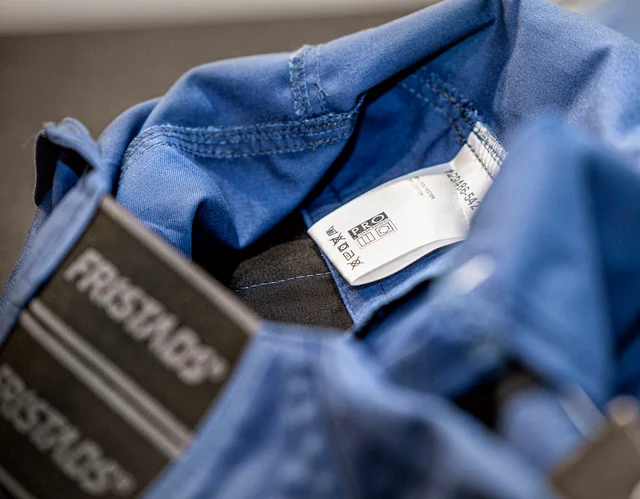
How to care for workwear
If you want your clothes to last long, opting for high quality is the first step. But even premium workwear can wear out prematurely unless you take care of it properly. Here are our best care tips for extending the lifespan of your work clothes.
Preparing your garment for washing
The washing instructions on the care label are there for a reason, so be sure to follow them. Use a damp cloth to remove loose dirt before you put your clothes in the washer or give them a quick rinse to prevent the debris from causing damage. Empty rocks, trash and other random objects out of the pockets.
Before putting the clothes in the washer, be sure to close zippers, button up pockets and secure velcro flaps, so they don’t get snagged on other garments or the washing machine. You can also protect the outside of the garment from damage by turning it inside out. Body odours and oils from your skin wash away more easily this way as well.

General washing instructions
Dirt hardens over time which makes your clothes harder to clean the longer you wait, so wash your work clothes and PPE regularly – probably more often than you think. Dirt also makes your clothes wear out faster and may in some cases affect the function and safety of the clothes, for example when it comes to high-vis garments.
Wash your work clothes separately from your personal clothes, since the latter may colour-bleed. Mixing workwear and personal clothes can also cause cross-contamination of germs. Choose a mild, biodegradable detergent that doesn’t contain bleach or other harsh chemicals, since they may damage the garments. Over time, bleach can compromise the flame-retardant properties of the cotton fabrics in flame-protective clothes, making them unsafe.
Never, ever use fabric softener when washing your workwear and PPE. It plugs up the pores of the garment, causing it to lose breathability. Plus, fabric softeners contain flammable components that can build up on fabrics over time and compromise the performance of your flame-retardant clothes.
Extending the life of your workwear
Be careful to choose the right size when you purchase workwear for yourself or your employees, since poor-fitting clothes are likely to get discarded sooner than necessary. Trousers that are too long will also fray when dragged on the ground.
Inspect your workwear and PPE for damages regularly and report defects immediately. Small holes and tears quickly grow bigger unless they are fixed right away, and it is a lot more economical to repair a garment than to replace it with a new one. For certified clothes, use the same material as the original to make sure your garment is still compliant.
Waterproof jackets and trousers need to be re-treated every few months and after being washed in order to maintain their water-repelling properties and breathability. Use either a waterproofing spray or detergent to keep the garments functional.

Replacing your workwear
Even with proper care, you will eventually need to replace your workwear. It is important to know when the time is right, especially with PPE which can become non-compliant and a safety hazard when excessively soiled and/or damaged. If your clothes are damaged beyond repair or have permanent stains that will not come out when you wash them, they are no longer safe and will need to be discarded. Ask your employer how to discard the clothes properly and in accordance with environmental regulations.
Making clothes that last
At Fristads, we want to do our part to cut unnecessary waste from clothing production and make sure each garment is used to its full potential. To this end, we have developed processes to continuously improve our products, from having durability as a design goal and choosing high-end materials to having a team of quality controllers that works closely with our suppliers to make sure they meet our stringent requirements. And in case a garment does not live up to our users’ expectations, our Claims and Returns Department works diligently to understand what the problem is and how to fix it.Whatever the cause of a claim may be, it is scrutinised thoroughly. We check that the garment has been sewn according to our instructions, question the supplier and suggest improvements to prevent the issue from occurring again. If the garment can be repaired, for example by replacing a zipper or button, rather than replaced with a new one, we do that. In 2020, approximately 0.001% of all garments sold resulted in a claim and of those, nearly 2 out of 10 garments were repaired instead of replaced with a new one. Our Value Added Services department fixed 136 buttons and 362 zippers in 2020.
More content for you:
Timeless classics
Our timeless classics are the garments that defy trends and truly stand the test of time. And they are as popular today as they were then.
Care & Repair
Reduce, reuse and repair. When it comes to sustainability in the workwear industry, Fristads is leading the charge.
Laundry guide
All the instructions you need to properly care for your Fristads product and maximise its durability, comfort and performance.





